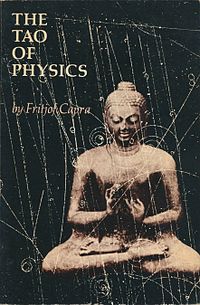The Tao of Physics

Cover of the first edition
|
|
| Author | Fritjof Capra |
|---|---|
| Country | United States |
| Language | English |
| Subject | Physics |
| Published | 1975 |
| Publisher | Shambhala Publications |
| Media type | Print (hardcover and paperback) |
| Pages | 356 pp. (Hardcover) |
| ISBN | |
| Followed by | The Turning Point |
The Tao of Physics: An Exploration of the Parallels Between Modern Physics and Eastern Mysticism is a 1975 book by physicist Fritjof Capra. It was a bestseller in the United States and has been published in 43 editions in 23 languages. The fourth edition in English was published in 2000.
The following excerpt from The Tao of Physics summarizes Capra's motivation for writing this book.
Science does not need mysticism and mysticism does not need science, but man needs both. – (epilogue)
According to the preface of the first edition, reprinted in subsequent editions, Capra struggled to reconcile theoretical physics and Eastern mysticism and was at first "helped on my way by 'power plants'" or psychedelics, with the first experience "so overwhelming that I burst into tears, at the same time, not unlike Castaneda, pouring out my impressions to a piece of paper". (p. 12, 4th ed.)
Capra later discussed his ideas with Werner Heisenberg in 1972, as he mentioned in the following interview excerpt:
I had several discussions with Heisenberg. I lived in England then [circa 1972], and I visited him several times in Munich and showed him the whole manuscript chapter by chapter. He was very interested and very open, and he told me something that I think is not known publicly because he never published it. He said that he was well aware of these parallels. While he was working on quantum theory he went to India to lecture and was a guest of Tagore. He talked a lot with Tagore about Indian philosophy. Heisenberg told me that these talks had helped him a lot with his work in physics, because they showed him that all these new ideas in quantum physics were in fact not all that crazy. He realized there was, in fact, a whole culture that subscribed to very similar ideas. Heisenberg said that this was a great help for him. Niels Bohr had a similar experience when he went to China.
As a result of those influences, Bohr adopted the yin yang symbol as part of his family coat of arms when he was knighted in 1947.
The Tao of Physics was followed by other books of the same genre like The Hidden Connection, The Turning Point and The Web of Life in which Capra extended the argument of how Eastern mysticism and scientific findings of today relate, and how Eastern mysticism might also have answers to some of the biggest scientific challenges of today.
...
Wikipedia
